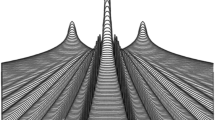Summary
We show that the free Dirac equation can be split into a pair of independent two-component first-order equations. The solutions λ and μ of the two-component equations are obtained as linear superpositions of the ordinary solutions ψ and\(\bar \psi \) of the Dirac equation and its adjoint one. The theory allows a simple interpretation in terms of «particles» and «antiparticles» consisting of electron-positron superposition states. TheC, P andT invariance properties of the two-component equations are investigated. The problem is made intricate by the well-known ambiguities in the definitions ofC, P andT for Fermi-Dirac particles. It follows that physically equivalent definitions ofC, P andT may involve completely different symmetry properties for the two-component equations. The equations are coupled by the electromagnetic interaction.
Riassunto
Si mostra che l’equazione di Dirac libera può essere decomposta in una coppia di equazioni a due componenti del primo ordine non interagenti. Le soluzioni λ e μ delle equazioni a due componenti sono ottenute come sovrapposizioni lineari delle soluzioni ordinarie ψ e\(\bar \psi \) dell’equazione di Dirac e della sua aggiunta. La teoria ammette una semplice interpretazione in termini di «particelle» e «antiparticelle» consistenti in stati di sovrapposizione di elettrone e positrone. Si studiano le proprietà di invarianza perC, P eT delle equazioni a due componenti. Il problema è complicato dalle ben note ambiguità che si hanno nelle definizioni diC, P eT per le particelle di Fermi-Dirac. Ne segue che definizioni fisicamente equivalenti diC, P eT possono implicare proprietà di simmetria completamente differenti per le equazioni a due componenti. Le equazioni sono accoppiate dall’interazione elettromagnetica.
Резюме
Мы показываем, что свободное уравнение Дирака может быть расщеплено на пару независимых двухкомпонентных уравнений первого порядка. Решения λ и μ двухкомпонентных уравнений получаются как линейные суперпозиции обычных решений ψ и\(\bar \psi \) уравнения Дирака и сопряженного уравнения. Рассматриваемая теория допускает простую интерпретацию в термнах «частиц» и «античастиц», представляющих суперпозицию электрон-позитронных состояний. Исследуются свойстваC, P иT инвариантности двухкомпонентных уравнений. Указанная проблема существенно запутана из-за хорошо известных неоднозначностей при определенииC, P иT для частиц Ферми-Дирака. Из этого следует, что физически эквивалентные определенияC, P иT могут включать полностью различные свойства симметрии для двухкомпонентных уравнений. Рассматриваемые уравнения связаны электромагнитным взаимодействием.
Similar content being viewed by others
References
H. Jehle:Phys. Rev.,75, 1609 (1949).
J. Serpe:Phys. Rev.,76, 1538 (1949).
W. L. Bade andH. Jehle:Rev. Mod. Phys.,25, 714 (1953).
See,e.g.,V.B. Berestetskii, E. M. Lifshitz andL. P. Pitaevskii:Relativistic Quantum Theory, Part 1 (Oxford, 1971).
M. Jacob andG. C. Wick:Ann. of Phys.,7, 404 (1959).
J. D. Bjorken andS. D. Drell:Relativistic Quantum Fields (New York, N. Y., 1965).
Author information
Authors and Affiliations
Additional information
Переведено редакцией.
Rights and permissions
About this article
Cite this article
Miglietta, F. Two-component first-order equations for the quantum-relativistic electron. Nuov Cim A 48, 189–201 (1978). https://doi.org/10.1007/BF02799674
Received:
Published:
Issue Date:
DOI: https://doi.org/10.1007/BF02799674




